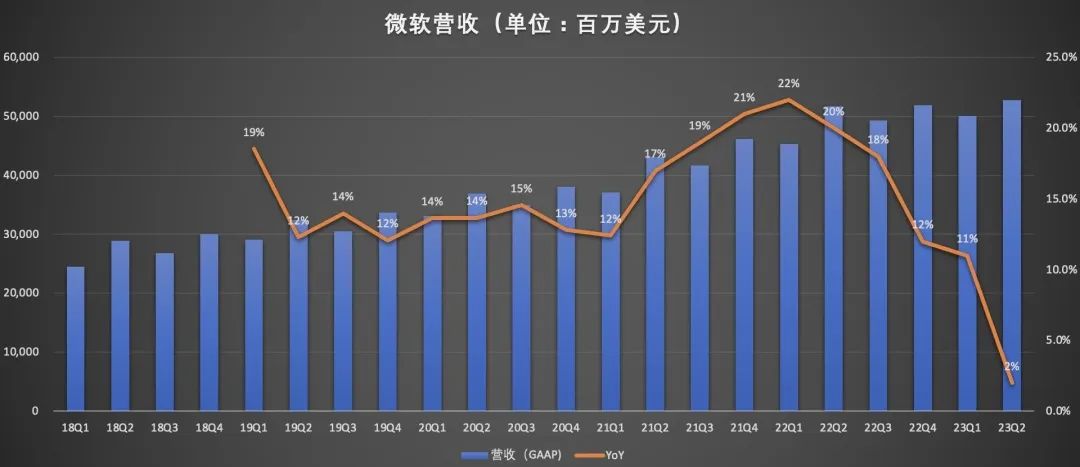The serious decline in net profit is driving performance growth. The intelligent cloud business is facing a continuous slowdown in growth. Artificial intelligence and metaverse, which strategy can support the company’s new growth point in the future?
After the close on January 24th, Eastern Time, technology giant Microsoft (NASDAQ: MSFT) released its financial performance report for the second quarter of fiscal year 2023 ending on December 31st. Judging from the disclosed data, the company’s net profit has fallen sharply. Although the performance of the cloud computing business, which has driven performance growth, has exceeded expectations, compared with the previous year-on-year growth rate, it has continued to slow down. Overall, the company’s Compared with the past, the performance of this quarter is much “lower”.
So, which information released by Microsoft’s financial performance this time deserves our attention?
In the short term, Microsoft’s performance growth and profitability may continue to be under pressure.
1. The decline in core business performance leads to a continuous slowdown in revenue growth
According to the financial report data, Microsoft will achieve a total revenue of US$52.7 billion in Q2 2023, a year-on-year increase of only 2%, a record low in the past six fiscal years.
Behind the slowdown in revenue growth, on the one hand, it is affected by the exchange rate, but the main reason is weak demand, which leads to the continuous decline in the performance of the company’s core business. According to a recent report released by research firm Gartner, in the fourth quarter of 2022, the growth of the global PC business hit a record low.
Microsoft CEO Satya Nadella told analysts on a conference call that Microsoft is facing a decline in the performance of its core business Windows+Office by the end of 2022.
Meanwhile, Microsoft Chief Financial Officer Amy Hood said the PC market will shrink again this year, leading to a roughly 17% year-over-year decline in the More Personal Computing segment, which includes businesses like Windows, Surface devices and Xbox.
Microsoft’s personal computing division mainly includes Windows, Xbox and Surface. In Q2 of the 2023 fiscal year, Microsoft’s personal computing division’s revenue was US$14.2 billion, a year-on-year decrease of 19%. Among them, Windows license sales to PC equipment manufacturers fell by 39% year-on-year, which was worse than the 15% decline in the first fiscal quarter.
The cloud business is the core driver of Microsoft’s revenue growth. The Intelligent Cloud Business Department mainly includes server products such as Azure public cloud, GitHub and Windows server.
Financial report data show that Microsoft Smart Cloud revenue was 21.5 billion US dollars, an increase of 18% year-on-year. Among them, the revenue of Azure and other cloud services was US$14.7 billion, a year-on-year increase of 31%, a decrease of 4 points compared with the previous quarter’s 35% year-on-year growth rate, and the growth rate has slowed down for four consecutive quarters. Nadella said that large organizations are optimizing their spending on cloud services. In order to help cloud customers optimize costs, Microsoft has also adjusted its product line to adapt to customers’ fee reduction trends.
2. Gross profit and net profit decline, and profitability is under pressure
Financial report data show that Microsoft achieved a gross profit of US$35.3 billion in the quarter, with a gross profit margin of 66.8%, lower than the 69.2% in the previous quarter. Generally, the higher the gross profit margin of a company, the stronger its profitability. The decline in Microsoft’s gross profit margin reflects a certain degree of pressure on Microsoft’s profitability.
In terms of net profit, it has declined year-on-year for two consecutive quarters. Microsoft’s net profit this quarter was US$16.4 billion, a year-on-year decrease of 12% and a quarter-on-quarter decrease of 6%. On the whole, Microsoft’s profit performance is indeed not good.
In terms of guidance, Microsoft expects third-quarter revenue to range from $50.5 billion to $51.5 billion. Microsoft Chief Financial Officer Amy Hood said on the earnings call that the company’s Windows commercial products and cloud services business may continue to experience slowdowns in the fiscal third quarter.
In the long run, artificial intelligence may become Microsoft’s new growth engine in the future.
Microsoft under the leadership of Nadella can be said to have been in a strategic transformation. Since 2014, Microsoft has made full efforts in cloud computing, mobile applications, intelligent hardware and other fields, and deployed cutting-edge technologies such as virtual reality, artificial intelligence, and quantum computing. The company’s revenue has also maintained a steady growth. The intelligent cloud business has become Microsoft’s core growth engine.
However, revenue growth in the Azure cloud computing services business has slowed, raising concerns among some investors. Microsoft’s diversification strategy is constantly advancing. Previously, Microsoft also used the “Metaverse” as a strategic focus, acquiring Activision Blizzard for $70 billion in cash, hoping to lead the next era by betting on the “Metaverse”.
Today, the “enthusiasm” of technology giants for the “metaverse” has diminished. After all, it is difficult to realize the short-term landing and commercialization of the metaverse in a short period of time. Microsoft’s metaverse strategy has also been adjusted, abandoning 2C. Metaverse business, focusing on 2B metaverse business.
Previously, Microsoft announced that it would lay off 10,000 employees before March 31. The affected employees accounted for nearly 5% of its total employees, and the Metaverse team was the first to bear the brunt. According to media reports, the teams behind social platform AltSpaceVR, MR headset HoloLens and mixed reality toolkit MRTK have all been disbanded.
Microsoft has mentioned the “industrial metaverse” many times before, and set up a dedicated team in October last year. The goal is to create a virtual world focused on industrial work that can detect and evaluate real-world machines and factory environments. 3 AltSpaceVR will be shut down on March 10, and the focus will turn to the MR mixed reality platform Mesh. The future focus will be on the B side.
While adjusting the metaverse strategy, Microsoft is also investing more resources in the field of artificial intelligence.
On January 23, Microsoft announced an additional multi-billion-dollar investment in OpenAI, an American artificial intelligence research company, to support OpenAI’s research and integrate OpenAI’s generative artificial intelligence-AI chatbot ChatGPT into its own Excel, PowerPoint and Bing After waiting for the product, ChatGPT will also be added to its Azure cloud service. At the same time, Microsoft is considering acquiring more shares of OpenAI and intends to invest another $10 billion in OpenAI.
In this quarter’s conference call, Nadella expressed his enthusiasm for Microsoft’s investment in AI dream factory OpenAI, as well as his bullishness for the upcoming wave of artificial intelligence. He believes that more artificial intelligence will help change the Azure infrastructure.
“This next phase of our partnership will enable developers and organizations across industries to use Azure to access the best AI infrastructure, models and toolchains,” Microsoft CEO Satya Nadella said in a statement. to build and run their applications.”
Rowan Curran, an AI analyst at Forrester Research, said: “Obviously Microsoft hopes to obtain considerable commercial returns through this partnership, but they can obtain more important short-term returns. The craze triggered by ChatGPT has made ChatGPT almost synonymous with AI. Microsoft This can be leveraged to increase demand for the Azure OpenAI API and broader AI/ML platform.”
Microsoft’s artificial intelligence and metaverse strategy will hardly have a substantial impact on Microsoft’s financial situation in the short term, but Azure is currently the world’s second largest cloud infrastructure platform, and Microsoft and OpenAI will join forces to challenge Google as the best AI development cloud The status of the platform and Microsoft’s strategic layout in artificial intelligence will help boost Microsoft’s stock price.
This article is from the WeChat public account “异观财经” (ID: DifferentFin) , author: Xuanye Baixue, published with authorization by 36 Krypton.
media reports
36Kr Titanium Media 36Kr
Event Tracking
- 2023-01-28Microsoft ’s second-quarter revenue fell short of market expectations, and its cloud business will continue to decelerate in the next six months
- 2023-01-25Microsoft ’s revenue in the second quarter of fiscal year 2023 is US$52.7 billion and net profit is US$17.4 billion
- 2022-10-25Microsoft ‘s revenue in the first fiscal quarter was US$50.1 billion, an increase of 11% year -on-year
- 2022-07-26 Microsoft’s fourth-quarter revenue was US$51.865 billion, an increase of 12% over the same period, and the stock price rose by more than 5% after the market
- 2021-10-27 Affected by the tense global chip supply chain, Microsoft Surface revenue continues to decline
This article is transferred from: https://readhub.cn/topic/8mW7nfKB69Y
This site is only for collection, and the copyright belongs to the original author.


